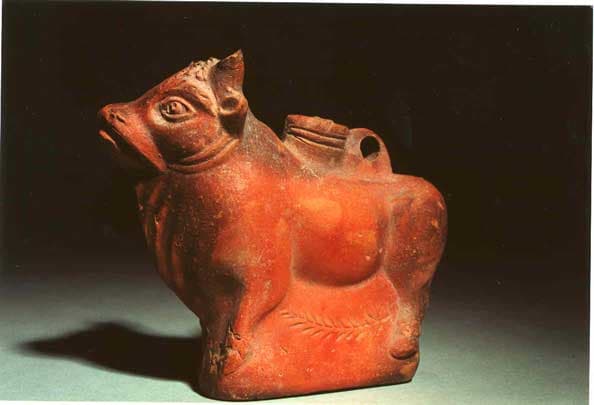Roman Terra Sigillata Vessel in the Form of a Standing Bull, 2nd Century CE
Terra Sigillata
1.75 x 4.5 x 5.125
X.0063
Terra sigillata wares were the classic fine wares of the Roman period. The roots of the industry go back to Italy during the 1st Century B.C. Building on the foundations...
Terra sigillata wares were the classic fine wares of the Roman period. The roots of the industry go back to Italy during the 1st Century B.C. Building on the foundations of a pre-existing industry dedicated to black-slipped ware, the glossy red-slipped terra sigillata wares were first produced at Arezzo, in northern Tuscany. The industry expanded, and factories producing Italian-type sigillata were founded across the Mediterranean world, notably southern France and northern Spain. Characterized by a red-orange to red-brown colored clay, these glossy household vessels were decorated by relief figures and incised designs.
This gorgeous vessel takes the form of a standing bull with his horned head raised upwards. There is a suspension loop directly behind the filling spout rising from the middle of the animal’s back and a hole in the mouth serves as the pouring spout. In Classical Antiquity, the bull was a symbol of strength and fertility. Jupiter was told to have transformed himself into a bull and the creature was the central animal in the cult of Mithras, an ancient religion imported from the east that gained popularity during the Roman Empire and influenced many of the legends of Christianity. Might this vessel have once played a central role in an ancient Mithraic ritual now lost to us? The sacrifice of a bull was the highest libation that could honor Mithras, and the blood was believed to provide fertility to the earth? Did bull’s blood once fill this vessel, so that this costly sacrifice could be reenacted later in private? As the rites of Mithras remain a mystery, it might be safer to assume that more mundane libations like oil were once contained within this bull-shaped vessel.
This gorgeous vessel takes the form of a standing bull with his horned head raised upwards. There is a suspension loop directly behind the filling spout rising from the middle of the animal’s back and a hole in the mouth serves as the pouring spout. In Classical Antiquity, the bull was a symbol of strength and fertility. Jupiter was told to have transformed himself into a bull and the creature was the central animal in the cult of Mithras, an ancient religion imported from the east that gained popularity during the Roman Empire and influenced many of the legends of Christianity. Might this vessel have once played a central role in an ancient Mithraic ritual now lost to us? The sacrifice of a bull was the highest libation that could honor Mithras, and the blood was believed to provide fertility to the earth? Did bull’s blood once fill this vessel, so that this costly sacrifice could be reenacted later in private? As the rites of Mithras remain a mystery, it might be safer to assume that more mundane libations like oil were once contained within this bull-shaped vessel.



